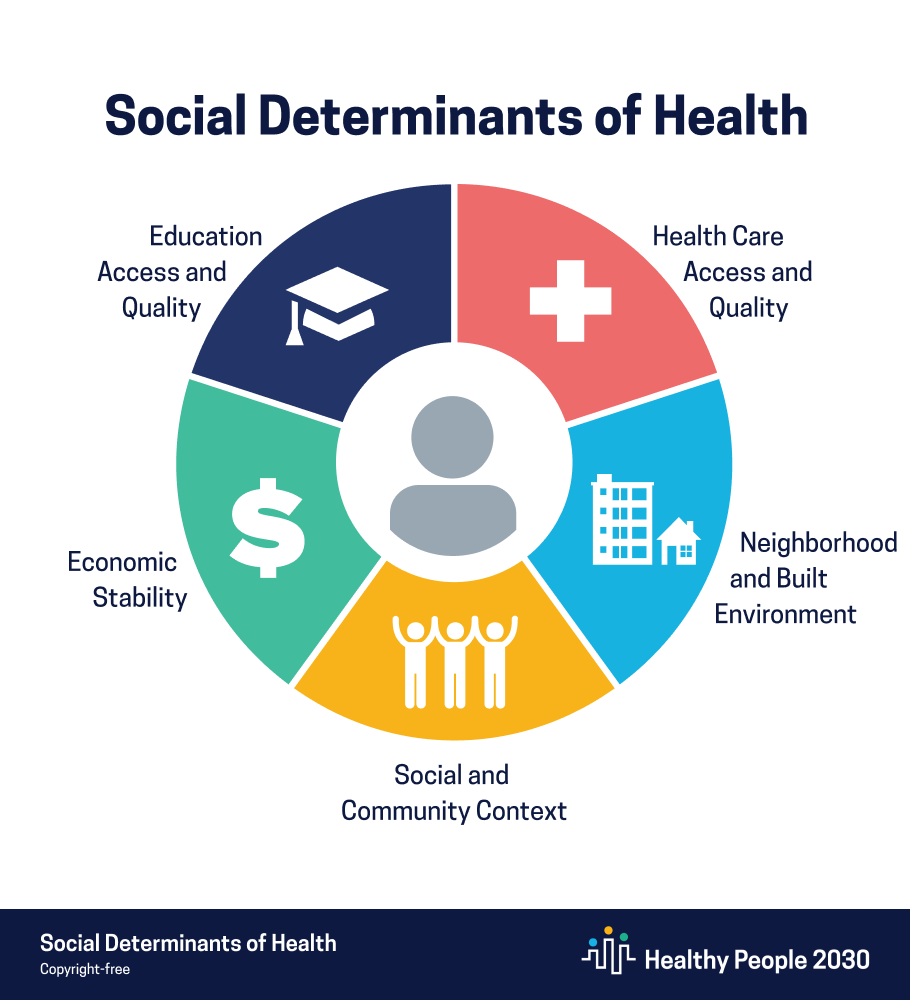10.4 Community and Organization Advocacy
Nurses advocate for issues in their communities and their organizations.
Addressing Social Determinants of Health
Advocacy is commonly perceived as acting on behalf of a client, but it can be a much broader action than affecting a single client and their family members. Nurses advocate for building healthier communities by addressing social determinants of health (SDOH). SDOH are the conditions in the environments where people live, learn, work, and play that affect a wide range of outcomes. SDOH include health care access and quality, neighborhood and environment, social and community context, economic stability, and education access and quality. Social determinants of health (SDOH) have a major impact on people’s health, well-being, and quality of life. See Figure 10.2[1] for an illustration of SDOH.[2]

Specific examples of addressing SDOH include the following goals:
- Improving safe housing and public transportation
- Decreasing discrimination and violence
- Expanding quality education and job opportunities
- Increasing access to nutritious foods and physical activity opportunities
- Promoting clean air and clean water
- Enhancing language and literacy skills[3]
SDOH contribute to health disparities and inequities among different socioeconomic groups. For example, individuals who don’t have access to grocery stores with healthy foods are less likely to have good nutrition, increasing their risk for health conditions like heart disease, diabetes, and obesity, and potentially lowering their life expectancy relative to people who do have access to healthy foods.[4]
One of Healthy People 2030’s goals specifically relates to advocacy regarding SDOH. The goal states, “Create social, physical, and economic environments that promote attaining the full potential for health and well-being for all.” Across the United States, people and organizations at the local, state, territorial, tribal, and national levels are working hard to improve health and reduce health disparities by addressing SDOH.[5] Read more information about these advocacy efforts in the following box.
Read more about efforts addressing SDOH at Healthy People 2030.
Understanding and addressing SDOH is crucial for effective health care advocacy, as it provides a comprehensive view of the various elements that impact clients’ well-being. These determinants include economic stability, education, social and community context, health and health care access, and the neighborhood and built environment.
Organization Advocacy
Nurses advocate for organizational issues in the nursing profession and the workplace through participation in unions, collective bargaining, workplace advocacy models, and professional organizations.
Unions and Collective Bargaining
A nursing union is a type of labor union that advocates for the interest of its nurse members. According to the Bureau of Labor Statistics, 20 percent of RNs and 10 percent of LPNs/VNs in the United States are union members.[7] Nursing union goals are typically to advocate for the improvement of benefits, wages, client safety, and workplace conditions. Advocacy is accomplished by collective bargaining. Collective bargaining refers to the negotiation of wages and other conditions of employment by an organized body of employees. See Figure 10.3[8] for an image of a union worker.

Although there is no single union that represents all nurses across the country, there are several nursing unions such as the National Nurses United, SEIU United Healthcare, and The United Food and Commercial Workers International Union. The National Nurses United union is the largest nursing union in the United States and has joined with other unions across the country to address unsafe staffing. Read more about these unions in the following box.
Read more about nursing unions:
Nursing unions can provide several potential benefits to the nursing profession. They may improve job security, improve working conditions, negotiate for better pay and benefits, protect seniority, establish staffing ratios, address workplace violence and incivility, and provide a well-defined grievance process. Unionized nurses earn an average of $200-$400 more per week than nonunionized nurses. Unions assist with grievance processes for resolving disagreements between employees and management. Examples of grievances include the promotion of one employee over another who has more seniority, disputes over holiday pay, and problems related to employee discipline.[9]
However, there are also potential disadvantages of unions, such as the cost of dues (up to $90/month per nurse), difficulty in removal of incompetent nurses, mandatory strikes with no pay, the issue of seniority taking precedence over good performance, and creation of working environments that can be adversarial between management and nursing. Additionally, many nursing unions are not organized or led by nurses, causing the belief that some unions are more interested in collecting dues than in improving the work environment for nurses. Although there has been research to determine if unions are good for nurses and good for clients, the findings are not conclusive. Some studies have shown that unionized hospitals have lower mortality rates, but higher failure-to-rescue and pressure injury rates. Another study found that unionized hospitals had higher levels of job dissatisfaction but higher levels of nurse retention.[10],[11]
Workplace Advocacy Models
Nurses can advocate for improvements in the workplace via various mechanisms, such as shared governance and the ANCC Magnet Recognition Program, and by participation in professional organizations. Nurses can also seek legislative solutions for workplace problems by advocating for legislation such as whistleblower protection.[12] Whistleblower protection is further discussed in the “Policy Advocacy” section of this chapter.
Shared Governance
Shared governance refers to a shared leadership model between management and employees working together to achieve common goals. Shared governance models are believed to promote nurses’ empowerment, engagement, autonomy, accountability, and collaboration while also striving to improve client safety, quality care, and positive outcomes. This style of management encourages and empowers nurses to be part of making decisions that impact their daily work environments. When organizations utilize a shared governance model, employees feel valued and invested in the organization’s success. Nurse engagement also improves both staff and client outcomes, such as increased job satisfaction and client satisfaction.[13] Implementation of a shared governance model has led to organizational cost savings, decrease in meeting times, fewer sick days used by employees, and a decrease in staff turnover.[14] See the following box for an example of effective shared governance.
Example of Effective Shared Governance[15]
A busy telemetry unit wants to address issues with low client satisfaction scores and an increase in both central line and indwelling catheter days. A quality improvement project is instituted by a multidisciplinary team that works to communicate the project’s goals and objectives, respecting each team member’s expertise and input. The team initiates daily multidisciplinary rounding on the unit. Six months after the implementation of multidisciplinary rounding, client satisfaction scores improve, and a decrease in both central line and indwelling catheter days is noted. Multidisciplinary rounding provides a collaborative team approach, acknowledging the expertise and leadership role of each discipline with the same end goal of improving client outcomes.
Magnet Recognition Program
Nurses can advocate for their excellence in the workplace by participating in activities required for Magnet Recognition. As previously discussed in this book, the Magnet Recognition Program is an organizational credential from the American Nurses Credentialing Center (ANCC) recognizing quality client outcomes, nursing excellence, and innovations in professional nursing practice. The Magnet Recognition Program requires nursing advocacy in the areas of technology, education, policies, and process development. This advocacy is accomplished by creating unit-based practice councils who meet regularly to discuss unit policies, practices, and outcomes. Additionally, an organization-wide practice council includes a representative from each unit council and reviews organizational-wide policies and practices. Read more about the Magnet Recognition Program in the following box.
Read more about the Magnet Recognition Program.
Professional Nursing Organizations
Professional organizations provide easy access to nursing advocacy work being done across the nation and the world. There are over 100 local, state, and national organizations that advocate for the nursing profession. Professional nursing organizations may advocate for specific nursing issues in certain areas of practice, such as critical-care nursing (American Association of Critical-Care Nurses, AACN) or broader national nursing issues, such as the American Nurses Association (ANA). Professional organizations also provide opportunities for continuing education, advanced certification, and participation in political action committees. Membership in state and national organizations helps nurses stay up-to-date on current evidence-based practices and research findings.
- “Healthy People 2030 SDOH Graphic.png” by U.S. Department of Health and Human Services, Office of Disease Prevention and Health Promotion is in the Public Domain. Access for free at https://health.gov/healthypeople/objectives-and-data/social-determinants-health ↵
- Healthy People 2030. (n.d.). Social determinants of health. U.S. Department of Health and Human Services. https://health.gov/healthypeople/objectives-and-data/social-determinants-health ↵
- Healthy People 2030. (n.d.). Social determinants of health. U.S. Department of Health and Human Services. https://health.gov/healthypeople/objectives-and-data/social-determinants-health ↵
- Healthy People 2030. (n.d.). Social determinants of health. U.S. Department of Health and Human Services. https://health.gov/healthypeople/objectives-and-data/social-determinants-health ↵
- Healthy People 2030. (n.d.). Social determinants of health. U.S. Department of Health and Human Services. https://health.gov/healthypeople/objectives-and-data/social-determinants-health ↵
- Healthy People 2030. (n.d.). Social determinants of health. U.S. Department of Health and Human Services. https://health.gov/healthypeople/objectives-and-data/social-determinants-health ↵
- Rowland, T. (2020). The pros and cons of nursing unions [Blog]. Soliant. https://blog.soliant.com/nursing/the-pros-and-cons-of-nursing-unions/ ↵
- “Debbie_Stabenow_marches_on_Labor_Day_2017_21318919_10155403813215528_8762450224354658172_o.jpg” by Office of Debbie Stabenow is in the Public Domain ↵
- Rowland, T. (2020). The pros and cons of nursing unions [Blog]. Soliant. https://blog.soliant.com/nursing/the-pros-and-cons-of-nursing-unions/ ↵
- Dube, A. Kaplan, E., & Thompson, O. (2016). Nurse unions and patient outcomes. ILR Review, 69(4), 803-833. https://doi.org/10.1177%2F0019793916644251 ↵
- Seago, J. A., Spetz, J., Ash, M., Herrera, C., & Keane, D. (2011). Hospital RN job satisfaction and nurse unions. Journal of Nursing Administration, 41(3), 109-114. https://doi.org/10.1097/nna.0b013e31820c726f ↵
- American Nurses Association. (n.d.). Five opportunities and challenges for workforce advocacy program. https://www.nursingworld.org/practice-policy/advocacy/ ↵
- Kroning, M., & Hopkins, K. (2019). Healthcare organizations thrive with shared governance. Nursing Management, 50(5), 13-15. https://doi.org/10.1097/01.numa.0000557781.40049.2d ↵
- Anthony, M. (2004). Shared governance models: The theory, practice, and evidence. Online Journal of Issues in Nursing, 9(1), 7. https://pubmed.ncbi.nlm.nih.gov/14998357/ ↵
- Kroning, M., & Hopkins, K. (2019). Healthcare organizations thrive with shared governance. Nursing Management, 50(5), 13-15. https://doi.org/10.1097/01.numa.0000557781.40049.2d ↵
Conditions in the places where people live, learn, work, and play, such as unstable housing, low income areas, unsafe neighborhoods, or substandard education that affect a wide range of health risks and outcomes.
Negotiation of wages and other conditions of employment by an organized body of employees.
A shared leadership model between management and employees working together to achieve common goals.
An organizational credential that recognizes quality patient outcomes, nursing excellence, and innovations in professional nursing practice.

